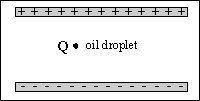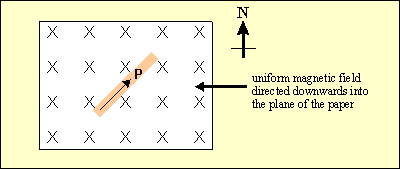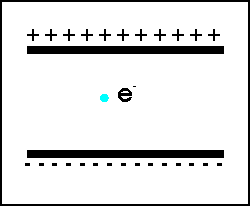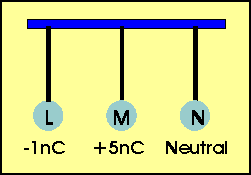Electrostatics 2
- A small negatively charged oil drop moves slowly downwards between two oppositely charged plates in a Millikan type experiment.
Taking which one of the following measures will not slow the drop down?

(A) Making the charge on the droplet more negative
(B) Decreasing the distance between the plates
(C) Increasing the potential difference across the plates
(D) Changing the polarity of the platesCorrect = D
- A length of wire is placed at right angles to a magnetic field as shown in the diagram below. The wire carries a current in the direction as shown by the arrow on the wire.

In what direction will a force be exerted on point P situated on the conductor as shown in the sketch?
(A) Upwards (out of the plane of the paper)
(B) Downwards (into the plane of the paper)
(C) At 900 to the wire on a bearing of 3150 (as shown in the diagram) electrostatics II, diagram 2a

(D) At 900 to the wire on a bearing of 1350 (as shown in the diagram) electrostatics II, diagram 2b

Correct = C
- When an inflated balloon is rubbed against a sweater the balloon acquires a negative charge. The balloon is then placed against a vertical wooden door and sticks to it. What is the reason for this?
(A) wooden doors naturally have a positive charge
(B) the negative charge on the balloon induces a positive charge on the surface of the door
(C) the surface of the door becomes negative by transfer of charge from the balloon
(D) the surface of the door becomes positive by transfer of charge from the balloonCorrect = B
- Two identical metal spheres P and Q are mounted on insulated stands. Sphere P carries a charge of +4nC and sphere B a charge of −4nC. The spheres are separated by a distance d and exert a force of magnitude F on each other. P and Q touch and are returned to half their original distance apart (d/2). What is the magnitude of the force they exert on each other?

(A) 0
(B) F
(C) 2 F
(D) 4 FCorrect = A
- An electron is between two oppositely charged parallel plates in a vacuum as shown in the sketch. Which one of the following statements about the acceleration is true?
The acceleration of the electron is …

(A) zero
(B) greatest close to the positive plate
(C) greatest close to the negative plate
(D) not zero, and the same everywhere between the platesCorrect = D
- Two identical sized conducting spheres A, with a charge of +3,2x10−19C, and B, with a charge of −6,4×10−19C, are allowed to touch. During touching, sphere A ...
(A) gains 3 protons
(B) loses 3 protons
(C) gains 3 electrons
(D) gains 2 electronsCorrect = C
- Three identical metal spheres L,M and N are suspended by non-conducting threads as shown. The charges on L and M are −1nC and +5nC respectively, while N is neutral. If M is first brought into contact with L and then with N, and separated again, the final charge on sphere N will be …

(A) +4nC
(B) +2nC
(C) +1,5nC
(D) +1nCCorrect = D
- Two point charges +Q1 and +Q2 are kept separated at a distance r. The force of repulsion between them is F. If each of the charges is doubled, the force of repulsion between the charges will be:
(A) 16F
(B) 8F
(C) 4F
(D) 2FCorrect = C
- The diagram below (a) shows two metal spheres, A and B, on insulating stands, touching each other.

A negatively charged rod is now brought close to A as in the diagram (b). While the negatively charged rod is held in the same position, sphere B is separated from sphere A, after which the negatively charged rod is removed (c). How will the charge on sphere B compare with the charge on sphere A?
(A) sphere B will have a negative charge of equal magnitude
(B) sphere B will have a positive charge of equal magnitude
(C) sphere B will have less negative charge
(D) sphere B will have no chargeCorrect = A
- Millikan's famous oil drop experiment showed that charge carried by oil drops was quantised. Apart from the mass of the oil drop, and knowledge of the acceleration due to gravity, which other quantities are required for this charge to be calculated?
(A) the velocity of the oil drop
(B) the voltage between the plates
(C) the voltage between the plates and the distance between them
(D) the voltage between the plates, the distance between them and the velocity of the oil dropCorrect = C







